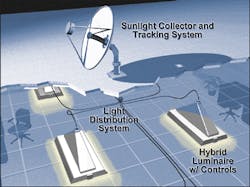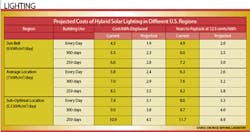An Even Smarter Lighting System
DISCLAIMER: This lighting technology is still in its research/development phase. There are beta systems currently being tested throughout the United States; future systems will incorporate the features presented in this article, although current beta systems do not produce electricity as future systems will.
Holding the future of lighting in the palms of their hands, the researchers at Oak Ridge National Laboratory in Oak Ridge, TN, have the potential to drastically change the way you manage your facilities’ power consumption. Their innovation is being hailed as the next big thing in commercial lighting (although using this all-too-common phrase as a description doesn’t begin to express the effects it could have on energy efficiency, productivity, and lighting quality).
The technology? Hybrid solar lighting (HSL). The claim? It takes advantage of sunlight’s positive aspects without the drawbacks associated with many of today’s daylighting systems. The concept of improving the way facilities currently make use of daylight is fairly simple, but the implications surrounding HSL are ground-breaking.
Buildings talks with Melissa Voss Lapsa, Ronald A. Walli, Dennis D. Earl, Jeff D. Muhs, L. Curt Maxey, and Dave L. Beshears, all of Oak Ridge National Laboratory’s Solar Technologies Program, to unveil what HSL will mean to building owners and facilities managers.
Meet HSL, Your New Energy-Efficiency Tool
Although the words “energy efficient” are regularly used in the commercial buildings industry, HSL has every right to make this claim. In U.S. commercial buildings, lighting devours more electric energy than any other building system and makes up more than one-third of all U.S. electricity consumption. On average, less than 25 percent of that energy actually churns out light; the rest generates heat, increasing the need for air-conditioning. With an HSL system, the energy required for lighting (and related air-conditioning loads) is significantly reduced, while power for other uses (heating, cooling, or supplemental lighting, for example) is produced.
In straightforward terms, HSL collects sunlight and transmits it via optical fibers into a building, where it’s sent to a special fixture containing both electric lamps and fiber optics (hence the word “hybrid” - it refers to the use of both sunlight and electric light). Sensors maintain interior light levels by altering electric lights based upon the availability of sunlight. This technique requires no energy conversion and divides sunlight into two parts (visible and infrared portions of the solar spectrum) for two separate purposes: interior lighting and distributed power generation. Making the most of sunlight in its pure form, HSL uses the solar spectrum’s visible segment for interior lighting (its luminous efficacy [light output per unit of energy] is more than twice that of electric lamps); it turns the infrared portion of the solar spectrum into electricity via photovoltaic cells.
This System Has Brains
Because of the hybrid characteristics of HSL, natural and electric light sources work together. A rooftop-mounted collector and secondary mirror track the sun during daytime hours. The collector system separates visible segments from infrared segments of sunlight and points the visible segment into 127 optical fibers (bundled into a single cord), which are attached to hybrid light fixtures. The fixtures are equipped with diffusion rods similar to fluorescent lamps, which extend and spread light in all directions. The infrared portion of the sunlight is rerouted to a concentrating solar cell that converts it into electricity. Currently, one collector powers between eight and 12 hybrid fluorescent light fixtures, which can supply light to about 1,000 square feet.
When there is sufficient sunlight available to the HSL system, it’s estimated that 80 percent of interior light is generated from the sun (the remaining 20 percent is created artificially). On cloudy days (or in the evening), more artificial light is used since sunlight isn’t easily collected. Photosensors automatically adjust how much electric current is needed at any given time to keep a room lit; conventional electronic ballasts automatically dim or brighten standard T8 fluorescent lamps or incandescent bulbs based upon the quantity of sunlight being piped into the building.
Due to the solar component of HSL, heat production is negligible (unlike a traditional incandescent bulb, you can actually touch the fibers of an HSL system with your hand). In the process of separating visible and infrared portions of sunlight, the collectors remove the infrared light (which generates the most heat) and direct it elsewhere, leaving interior lighting fixtures cool to the touch.
A Different Kind of Solar
When compared to other solar systems on the market, HSL stands out for its proficiency and effectiveness - it’s likely to be 10-times more efficient than photovoltaics in terms of lighting. HSL’s solar-distribution process is much more resourceful than conventional solar-conversion techniques; rather than using solar panels, which convert solar energy into electricity, store that electricity, and then use it to power lights, HSL seizes sunlight and distributes it directly into an interior room while otherwise-squandered infrared energy is transformed into electricity. Because of the way they work, traditional solar panels end up utilizing roughly 15 percent of the sunlight they collect; artificial lamps, such as incandescent bulbs, lose the bulk of their energy in the form of heat. The result is an overall efficiency of about 2 percent of the original sunlight collected. Quite the opposite, HSL has the potential to use as much as 50 percent of gathered sunlight. By avoiding the added steps of converting sunlight into electricity and then converting that electricity back into light again, HSL boasts much higher efficiency levels. However, for complete use of solar resources, an HSL system can be teamed with a photovoltaic system to provide any remaining electrical demand and maximize the solar resources used for lighting.
In terms of conventional daylighting techniques, HSL may outperform them as well. The system offers the advantages of natural lighting without the shortcomings associated with traditional daylighting technologies (including heat loss or heat gain, constraints of building shape and orientation, uncontrolled/irregular illumination, minimum use of available sunlight, leakage from windows/skylights, etc.) And, although many of today’s daylighting tactics are designed to overcome the problems of glare, difficulty of control, and illumination, they usually wind up wasting much of the visible light by covering, attenuating, or diffusing it.
Where HSL Works
This system is practical in many applications. Oak Ridge National Laboratory predicts that, initially, the uses of HSL in commercial buildings will most likely be on the uppermost two floors of facilities that are: (1) located in the Sun Belt or in a region where daytime electricity costs are steep; (2) occupied every day, including weekends; and (3) in need of good lighting quality or color rendering. Although being located in the Sun Belt region is valuable in terms of the energy savings seen from HSL, the technology will work in any region of the United States. Oak Ridge National Laboratory points out that many of its beta-site partners are in Northern U.S. regions, where the sun is sometimes scarce. In these locations, higher premiums are placed on natural light and HSL’s features are still valuable.
COURTESY OF OAK RIDGE NATIONAL LABORATORY
Keep in mind, however, that HSL technology isn’t well-matched to wooden-framed buildings or heavily pitched roofs. To capitalize on HSL systems, facilities need to have moderate solar exposure (a 20-story building in the center of Manhattan, where other buildings are shading the solar view, isn’t an ideal contender for HSL). At this time, fiber-length restrictions also make the technology pertinent to lighting only the top one or two floors.
In many new-construction projects and high-bay situations, the latest skylights can do well in terms of delivering natural light to an indoor space - HSL may be a complicated and expensive solution that isn’t recommended in these situations. According to Oak Ridge National Laboratory, however, HSL is a sophisticated technology that is best suited to environments that require controlled natural lighting (such as retail space), have low ceiling heights not suitable for skylights (such as offices and classrooms), or involve a multi-faceted need that can be met by the flexibility of an optical fiber system.
Big Payoffs
Because it has the potential to use sunlight for both interior light and power generation, HSL will radically trim system costs and cost per lumen. Not unlike other solar technologies, anticipated payback is based on a 50-percent reduction in system cost once HSL is readily available in high volume across the nation.
In a comparative analysis, the approximate additive cost of an installed HSL system in terms of cents per kilowatt-hour was typically lower than the cost of an electric lighting system in a deregulated market (considering time-of-day rates during peak-demand periods).
Right now, one HSL unit (with an illumination capability of approximately 1,000 square feet) costs $16,000 before any installation fees (installation ranges from $500 to $2,000, depending on site specifics). To offset these costs, there is a 30-percent federal tax credit for HSL technology. Some states offer an additional state rebate on top of the federal tax credit. In some states, such as Hawaii, the final price (after incentives) is closer to $8,000 per unit. Costs also drop in applications involving multi-unit installations.
In terms of dollars, HSL’s future is clear: A few years ago, a Landover, MD-based ANTARES Group Inc. report revealed that HSL is equipped to become more cost effective than the most efficient daylighting system commercially available today.
Coming Soon to a Facility Near You
Presently in the beta-test phase at different locations across the United States, HSL is being used at Sacramento Municipal Utility District’s customer service headquarters in Sacramento, CA; San Diego State University in San Diego; the University of Nevada, Las Vegas, in Las Vegas; a Wal-Mart store in McKinney, TX; Pacific Northwest National Laboratory in Richland, WA; a Staples store in Long Island, NY; and Aveda Corp. in Minneapolis. From educational facilities to retail corporations, HSL is being tested (with remarkable success) in a variety of settings.
With speculation that HSL will soon become the desired way to bring sunlight inside, close to 1 million HSL systems may possibly be in operation by 2020, saving billions of dollars annually. And, if estimates are accurate, in the next 5 years, 5,000 HSL systems could be installed in the United States, saving 50 million kilowatt-hours each year.
The state-of-the-art system will be commercially available in 2007; it’s expected to take 2 to 3 years for prices to fall to a level that will allow the technology to be widely accepted.
Leah B. Garris ([email protected]) is senior associate editor at Buildings magazine.


